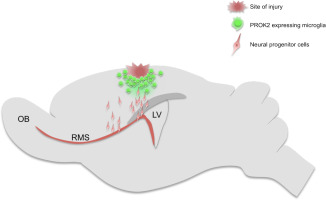Molecular and Cellular Neuroscience ( IF 2.6 ) Pub Date : 2018-11-01 , DOI: 10.1016/j.mcn.2018.10.004 Mayara Vieira Mundim , Laura Nicoleti Zamproni , Agnes Araújo Sardinha Pinto , Layla Testa Galindo , André Machado Xavier , Isaias Glezer , Marimélia Porcionatto

|
Traumatic brain injury is an important cause of global morbidity and mortality. After an initial injury, there is a cascade of cellular and molecular events that ultimately lead to cell death. Therapies aim to both counteract these mechanisms and replenish the lost cell population in order to improve recovery. The adult mammal brain has at least two neurogenic regions that maintain physiological functions: the subgranular zone of the dentate gyrus in the hippocampus, which produces neurons that integrate locally, and the subventricular zone (SVZ) adjacent to the lateral ventricles, which produces neuroblasts that migrate through the rostral migratory stream (RMS) to the olfactory bulbs. Brain injuries, as well as neurodegenerative diseases, induce the SVZ to respond by increasing cell proliferation and migration to the injured areas. Here we report that cells migrate from the SVZ and RMS to the injured cortex after traumatic brain injury in mice, and that the physiological RMS migration is not impaired. We also show that Prokineticin 2 (PROK2), a chemokine important for the olfactory bulb neurogenesis, expressed exclusively by cortical microglia in the cortex as early as 24 h after injury. We then show that administration of a PROK2 receptor antagonist decreases the number of SVZ cells that reach the injured cortex, while injection of recombinant PROK2 into the cortex of uninjured mice attracts SVZ cells. We also demonstrate that cells expressing PROK2 in vitro directionally attract SVZ cells. These data suggest that PROK2 could be utilized in regeneration efforts for the acutely injured mammalian cortex.
中文翻译:

Prokineticin 2的一项新功能:在创伤性脑损伤的小鼠模型中,SVZ衍生的神经母细胞募集至受伤的皮层
颅脑外伤是全球发病率和死亡率的重要原因。初始损伤后,会发生一系列细胞和分子事件,最终导致细胞死亡。治疗旨在既抵消这些机制又补充丢失的细胞群体以改善恢复。成年哺乳动物的大脑至少有两个维持生理功能的神经源性区域:海马中的齿状回的亚颗粒区,产生局部整合的神经元;与侧脑室相邻的脑室下区(SVZ),产生神经母细胞。通过眼部迁徙流(RMS)迁移到嗅球。脑损伤以及神经退行性疾病会诱导SVZ通过增加细胞增殖和迁移至受伤区域来做出反应。在这里,我们报道小鼠颅脑损伤后细胞从SVZ和RMS迁移到受伤的皮层,并且生理RMS迁移没有受到损害。我们还显示,Prokineticin 2(PROK2),一种对嗅球神经发生重要的趋化因子,仅在损伤后24小时内由皮层中的皮质小胶质细胞专门表达。我们然后表明,PROK2受体拮抗剂的管理减少了到达受伤皮层的SVZ细胞的数量,而将重组PROK2注射到未受伤小鼠的皮层中则吸引了SVZ细胞。我们还证明了表达PROK2的细胞 一种对嗅球神经发生重要的趋化因子,仅在受伤后24小时才由皮质中的皮层小胶质细胞表达。我们然后表明,PROK2受体拮抗剂的管理减少了到达受伤皮层的SVZ细胞的数量,而将重组PROK2注射到未受伤小鼠的皮层中则吸引了SVZ细胞。我们还证明了表达PROK2的细胞 一种对嗅球神经发生重要的趋化因子,仅在受伤后24小时才由皮质中的皮层小胶质细胞表达。我们然后表明,PROK2受体拮抗剂的管理减少了到达受伤皮层的SVZ细胞的数量,而将重组PROK2注射到未受伤小鼠的皮层中则吸引了SVZ细胞。我们还证明了表达PROK2的细胞体外定向吸引SVZ细胞。这些数据表明,PROK2可用于急性受伤的哺乳动物皮质的再生工作。











































 京公网安备 11010802027423号
京公网安备 11010802027423号